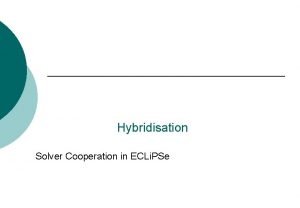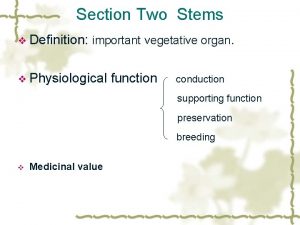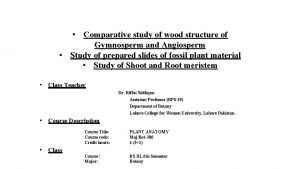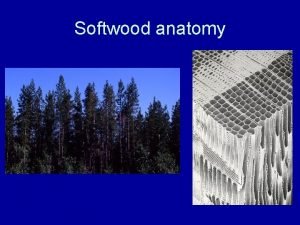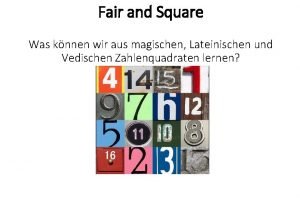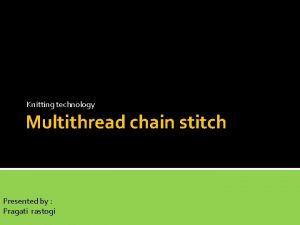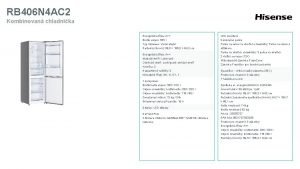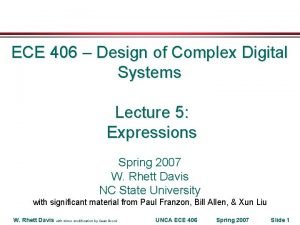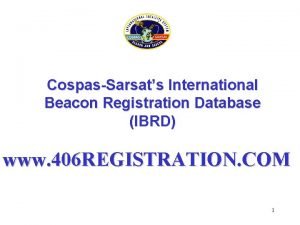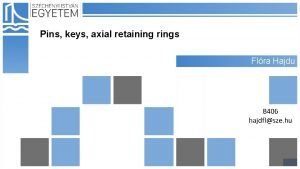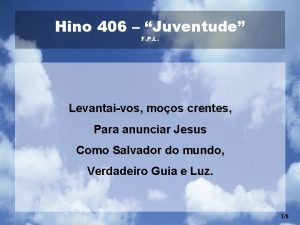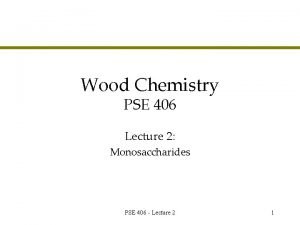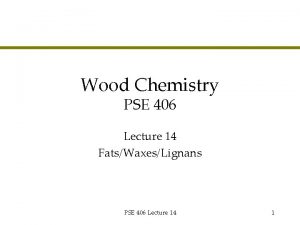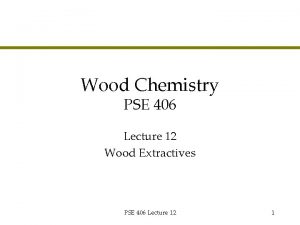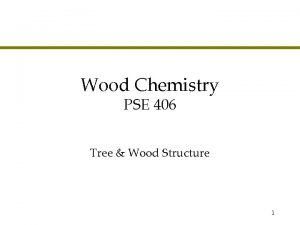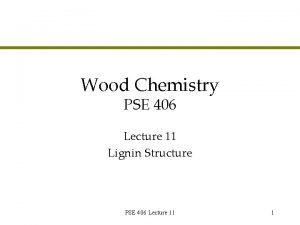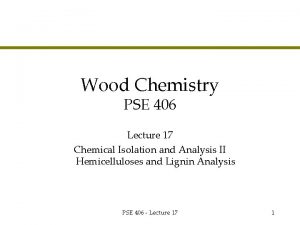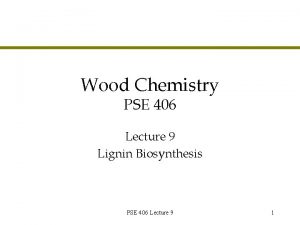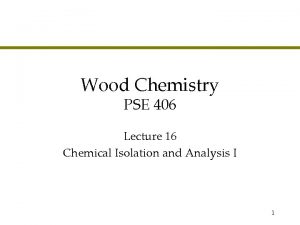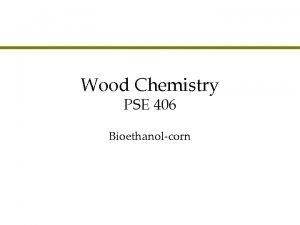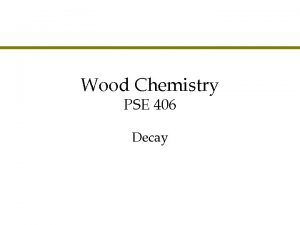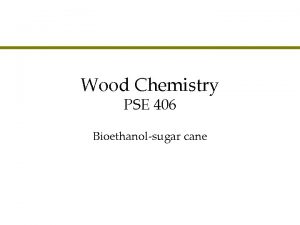Wood Chemistry PSE 406 Lecture 8 Hemicellulose II



















- Slides: 19

Wood Chemistry PSE 406 Lecture 8 Hemicellulose II PSE 406 - Lecture 8 1

Class Agenda l l l Arabinogalactans Grasses Minor Species » Glucans » Galactans » Pectins l l Starch Chitin PSE 406 - Lecture 8 2

Arabinogalactan l l Minor hemicellulose except in Larch » 10 -20% of Larch » 0. 5 -3% of other woods DP ~ 220 Backbone 1 3 -D-Galactopyranose units Branches: Nearly every galactose in backbone attached 1 6 to: » -D-Galactopyranose » -L-Arabinofuranose, -L-Arabinopyranose » -D-Glucopyranosyluronic acid Text PSE 406 - Lecture 8 3

Arabinogalactan 1 -D-Gal 1 1 R -L-Araf 3 1 -D-Gal 6 3 - -D-Gal -1 3 - -D-Gal -1 6 6 6 1 -L-Ara R = galactopyranose or L-Arabinofuranose or D-glucopyranosyluronic acid PSE 406 - Lecture 8 4

Pectins l l l Often described as water soluble extractives, not as hemicelluloses. Found in middle lamella and primary cell wall. Pectins is a class of several compounds » Galactans » Galacturonans: – Rhamnogalacturonan: 1 4 galacturonic acid backbone with rhamnose 1/8 units, sidechain of galcturonic units » Arabinans – 90% arabinose linked 1 5 PSE 406 - Lecture 8 Text 5

Grasses l l Arabionoxylan-are naturally found in the bran of grasses and grains such as wheat, rye, and barley DP 1500 – 5000 Xylan backbone; L-Araf (1α→ 2 and or 1α→ 3 linkages) Ratio A: X depends on the species PSE 406 - Lecture 8 6

Arabinoxylan PSE 406 - Lecture 8 7

Schematic structure of corn fibre arabinoglucuronoxylans (Saulnier and Thibault, 1999). PSE 406 - Lecture 8 8

Model of the corn fibre cell walls (Saulnier and Thibault, 1999) PSE 406 - Lecture 8 9

Glucans l Glucans are very minor components in wood. » The major representatives of this group are starch and callose. – Starch l l Amylose: 1 4 -D-Glucopyranose Amylopectin: 1 4 -D-Glucopyranose + 1 6 D Glucopyranose – Callose 1 3 -D-Glucopyranose Text PSE 406 - Lecture 8 10

PSE 406 - Lecture 8 11

Callose l Callose is found in very minor amounts in wood. » Small granular hemicelluloses found in a few isolated locations. l l Polymer of 1 3 -D-Glucopyranose Forming fibrillar structures PSE 406 - Lecture 8 12

Starch in Plants l Starch serves as an energy reserve in plants. » High concentrations of starch are found in seeds, bulbs, and tubers. » Starch can be as high as 7080% of certain tubers and seeds. l Wood contains minor amounts of starch in the form of granules in living parenchyma cells. » Typical amounts: 0. 2 -0. 6% of total wood » Sapwood >3% PSE 406 - Lecture 8 13

Chemical Composition of Starch l l Plants contain two types of starch, linear (helix) amyloses and branched amylopectins. The amounts of each of these starch types present is plant dependent. » Typical amounts are 25% amylose, 75% amylopectin » Mutant species can have from 50 -90% amylose PSE 406 - Lecture 8 14

Amylose l l 1 4 -D-Glucopyranose Because of the bonding, this molecule forms a helix » It takes 6 gluopyranose units for each turn » Addition of iodide to amylose results in a deep blue color. It is believed to b » Amylose is not water soluble PSE 406 - Lecture 8 15

Amylopectin l l 1 4 DGlucopyranose + 1 6 D Glucopyranose Amylopectin is a branched polymer » Branching inhibits helix formation » This starch is therefore somewhat water (hot) soluble. PSE 406 - Lecture 8 16

Isolation of Starch l l From tubers (potato, tapioca, etc. ) » Wet tuber is ground fine. » Hot water dissolves soluble fraction of tuber. » Insoluble starch is separated from the liquid phase. » Starch is dried. From corn » The skin and the germ (oil containing portion) are mechanically removed from the kernel after soaking in water. Isolation of the starch is then similar to tubers. PSE 406 - Lecture 8 17

Chitin l Cellulose type polymer found in insects and crustaceans; used in making the hard exoskeletons (~30%). Second or third most abundant biopolymer. » Second most abundant if you study this kind of thing for a living. PSE 406 - Lecture 8 18

Chitin Structure l Chitin is an amino polysaccharide » It is a linear polymer of 1 4 -D-Glucopyranose units just like cellulose » The difference is that the hydroxyl group of C 2 has been replaced by an amide group PSE 406 - Lecture 8 19
 Pse wood meaning
Pse wood meaning Pse wood meaning
Pse wood meaning Wood wood teenager
Wood wood teenager Early and late wood difference
Early and late wood difference Gymnosperm structure
Gymnosperm structure Esau wood poem
Esau wood poem Softwood anatomy
Softwood anatomy 01:640:244 lecture notes - lecture 15: plat, idah, farad
01:640:244 lecture notes - lecture 15: plat, idah, farad 406 afsb
406 afsb 2017 nec code changes
2017 nec code changes Magisches quadrat 8x8 406
Magisches quadrat 8x8 406 401 stitch type
401 stitch type Pharm406
Pharm406 Hisense rb 406 n 4 ac 2
Hisense rb 406 n 4 ac 2 Ece 406
Ece 406 International beacon registration database
International beacon registration database 406 woodruff key dimensions
406 woodruff key dimensions Ece 406
Ece 406 Cs 406
Cs 406 Despertai vos levantai vos
Despertai vos levantai vos
